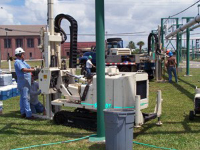Engineering Technical Support Center (ETSC)
 The Engineering Technical Support Center (ETSC) provides technical support for soil, sediment, groundwater and mining-related contamination.
The Engineering Technical Support Center (ETSC) provides technical support for soil, sediment, groundwater and mining-related contamination.
ETSC is one of EPA’s technical support and resource centers responsible for providing specialized scientific and engineering support to decision-makers in the EPA's program and ten regional offices. EPA’s regional offices work with states, communities, and local businesses within their area. These decision-makers include remedial project managers, corrective action staff, and on-scene coordinators.
- What We Can Do For You
ETSC delivers expertise on the latest methods, approaches, and technologies to characterize, remediate, and manage pollution at contaminated sites. We supply scientific and engineering knowledge and expertise in soil, sediment, and mine waste. ETSC provides site-specific technical assistance at
- Superfund,
- RCRA,
- brownfields, and
- ecosystem restoration sites.
ETSC also develops and conducts
- treatability studies, modeling support and site-specific document reviews;
- workshops, seminars, and conferences on state-of-the-science issues; and
- publications on remediation and treatment technologies for Superfund, RCRA, brownfields, and other contaminated site issues.
- Site Specific Assistance
In FY14, ETSC responded to approximately 270 technical support requests from over 120 contaminated sites in the U.S., its territories (Puerto Rico) and internationally (Vietnam and Canada). Seventy-five percent of the contaminated site requests were Superfund National Priority List (NPL) sites. Some on-going examples of ETSC support include:
Modeling of possible dam breach at the Argonaut Mine (Jackson, CA)
ETSC in conjunction with a contractor is working on a debris flow model for the Argonaut Mine in Jackson, CA. This model will estimate the effects if a breach of the Eastwood Multiple Arch Dam occurs. This dam contains tailings from the Argonaut mine.
Black Butte Mine and Cottage Grove Reservoir (Willamette Valley, OR)
The Black Butte Mine is a historic mercury (Hg) mine located in the Willamette Valley, OR. It produced approximately 700 tons of elemental Hg. The site was added to the Superfund list in part due to the community’s concern about Hg levels in the reservoir fish. The majority of the Hg that accumulates in the fish is an organic form of mercury (methylmercury-MeHg). MeHg is more toxic than elemental mercury. From 2012 to 2014, Region 10 and ETSC scientists collaborated to understand the fate and transport mechanisms at play transforming the elemental Hg to MeHg. The research team gathered and analyzed samples. The research indicates that seasonal water level fluctuations and elemental sulfur cycling within the reservoir influences elemental Hg transformation to MeHg. EPA's research effort now focuses on controlling parameters in the watershed that can reduce the production of MeHg.
- Publications
- Resources
ETSC connects regional staff with the specialized technical engineering expertise. Available resources include
- a core team of scientists and engineers providing a readily available source of interdisciplinary support;
- scientists and engineers with experience in a broad range of disciplines related to land and water remediation and pollution control available for consultation;
- expert technical support from universities and research institutions; and
- additional support from contractors, and specialized consultants.
- Technical Contact
Contact us to ask a question, provide feedback, or report a problem.
John McKernan, ScD, CIH
Captain, U.S. Public Health Service
Director, Engineering Technical Support Center
513-569-7415
Related Information
Contamination Clean-up Information: About Remediation Technologies
